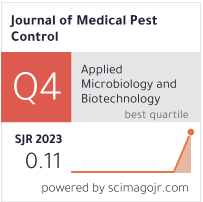Immunohistochemical evaluation of the effect of Botox-A in the prevention of burn scar formation (An experimental study)
Abstract
ABSTRACT
Background: Burn scars hurt survivors' capacity to go about their everyday lives, lowering their standard of living and causing aesthetic and functional problems. Botulinum toxin A was investigated to enhance Burning scars by several researches.
Aims: To study the impact of botulinum toxin-A on burning scars in the skin by evaluating the level of immunohistochemistry cluster of differentiation 31 (CD31) and matrix metalloproteinases (MMP-9).
Materials and methods:10 Male albino rabbits weighing 1.5± 0.2 kg and aged 6-8 months each had injected (6 units of Botox/Kg = 0.6 milliliters volume) Botox groups and 0.6 ml normal saline (control groups) into subcutaneous with 5 cm between them the animals were divided into groups A and B, with five rabbits in each group. Botox injections were given at different times: group A after 24 hours, group B after 7 days, and then all animals were euthanized at 28 days. Immunohistochemical investigation of skin samples concentrated on two parameters represented by CD31 and MMP-9.
Results: Immunohistochemical findings show that Botox groups have improved Immunohistochemical scores and increased levels of CD31 and MMP-9 compared to control.
Conclusion: This study concludes that Botox may inhibit fibroblast proliferation and regulate extracellular matrix formation. This may prevent scar formation.
Keywords: burn scars, Botox, CD31, MMP9.
Full text:
PDFReferences
ABDULRAZAQ HAMEED NEAMAa*, ABDULHAMEED N. ALDABAGH, ABDULSATTAR SALIM MAHMOOD



